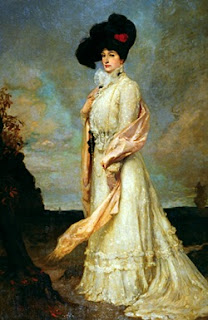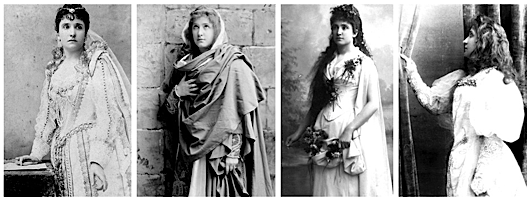 |
| Portrait by Rupert Bunny (1902) |
 |
"Depuis le jour" Louise by Charpentier (rec. 1913) |
1912 had Coombe Cottage built. The architect was John Grainger, father of the composer Percy Grainger. Coombe Cottage is now the residence of Melba's granddaughter, Pamela, Lady Vestey (the mother of the 3rd Lord Vestey). After catching a fever while traveling in Egypt, she returned to Australia but died in St Vincent's Hospital, Sydney in 1931, aged 69, of septicaemia which had developed from facial surgery in Europe some time before. She was given a state funeral from Scots' Church, Melbourne, which her father had built and where as a teenager she had sung in the choir. Melba was buried in the cemetery at Lilydale, near Coldstream. Her headstone bears Mimi's farewell words: "Addio, senza rancor."
 |
| Dame Nellie Melba as Lucia (Paris 1888), Juliette, Ophélie (1889), Juliette (Paris, 1897) |
NAMED IN HER HONOR
Four food items created by French chef Auguste Escoffier of the Savoy Hotel in London: Peach Melba is a classic dessert, invented in 1892 or 1893, to honour the Australian soprano. It combines two favourite summer fruits: peaches and raspberry sauce accompanying vanilla ice cream. In 1892, Nellie Melba was performing in Wagner's opera Lohengrin at Covent Garden. The Duke of Orléans gave a dinner party to celebrate her triumph. For the occasion, Escoffier created a new dessert, and to display it, he used an ice sculpture of a swan, which is featured in the opera. The swan carried peaches which rested on a bed of vanilla ice cream and which were topped with spun sugar. In 1900, Escoffier created a new version of the dessert. For the occasion of the opening of the Carlton hotel, where he was head chef, Escoffier omitted the ice swan and topped the peaches with raspberry purée. Other versions of
 |
| Melba was the first diva to have foods, money, stamps and even a cigarette advertisement with her name attached. |
HONORED IN AUSTRALIA
Melba, Australian Capital Territory, a suburb of Canberra, Australia. Melba Gully State Park, an environmentally significant area of the Otway Ranges. Melba Conservatorium Victoria, a music school associated with Victoria University. Melba Highway in Australia. The Canberra suburb of Melba is named for her. The current Australian 100 dollar note features the image of her face. Melba House at the school Melbourne Girls College in Richmond, Melbourne.
 |
| The soprano in 1903 |
-She was appointed Dame Commander of the British Empire in 1918 for her charity work during World War I, and was elevated to Dame Grand Cross of the British Empire in 1927. She and Dame May Whitty were the first entertainers to be awarded the honour of Dame Commander of the British Empire.
-Recordings for HMV always cost at least one shilling more than any other singer's, having their own distinctive mauve label as well.
-She wore couture costumes by Worth of Paris with accessories fashioned by Cartier and Fabergé.
-Melba was the first Australian to appear on the cover of Time magazine, in April 1927.
-She sang "God Save the King" at the official opening of Parliament House in Canberra on May 9, 1927.
-Melba became associated with the song "Home sweet home". She inherited it from Adelina Patti as Prima Donna Assoluta and after many performances the piano would be wheeled out and she would accompany herself singing the song. Joan Sutherland carried on the tradition.
-She sang for King Oscar II of Sweden, Tsar Alexander III of Saint Petersburg, Emperor Franz Joseph in Vienna, Kaiser Wilhelm II in Berlin, King George V and Queen Mary in London, and Queen Victoria at Windsor.
-Melba served as Patroness (President) of the Melbourne Symphony Orchestra from 1921–1932.
-She taught Australian lyric soprano, Stella Power, herself at the Albert Street Conservatorium, East Melbourne. She also helped young singers Gertrude Johnson, Toti Dal Monte, Browning Mummery, John Brownlee and Florence Austral.
"Se Saran Rose" by Luigi Arditi sung by soprano Stella Powers
-She was the first artist of international renown to participate in direct radio broadcasts beginning in June 1920 when she sang two arias and her famous trill from Guglielmo Marconi's factory in Chelmsford, England.
 |
"Caro nome" Rigoletto by Verdi |
-Melba makes an appearance in the 1946 novel Lucinda Brayford by Martin Boyd. Melba attends a garden party thrown by Julie and Fred Vane, mother of the eponymous heroine. Melba sang two or three songs, "Down in the Forest," Musetta's Waltz from Boheme and finally "Home, Sweet Home." She is described as having the "loveliest voice in the world."
-In 1953, Patrice Munsel played the title role in Melba, a biopic about the singer.
-January 13 is National Peach Melba Day in the United States.
 |
"Je veux vivre" Roméo et Juliette by Gounod |
Melba's first recordings were made c.1895-96, recorded on cylinders at the Bettini Phonograph Lab in New York. A reporter from Phonoscope magazine was impressed - "The next cylinder was labelled ‘Melba’ and was truly wonderful, the phonograph reproducing her wonderful voice in a marvelous manner, especially the high notes which soared away above the staff and were rich and clear." Melba was less impressed- "Never again, I said to myself as I listened to the scratching, screeching result. Don’t tell me I sing like that, or I shall go away and live on a desert island." The recordings never reached the general public - destroyed on Melba's orders, it is suspected - and Melba would not venture into a recording studio for another eight years.
Melba can be heard singing on several Mapleson Cylinders, early attempts at 'live' recording, made by the Metropolitan Opera House librarian Lionel Mapleson in the auditorium there during performances. These cylinders are often poor in quality, due to the inherent nature of the early recording process, the placement of the equipment (particularly poor in the case of those Melba is heard in), and repeated playings of favourite cylinders by Mapleson over many years; they do, however, preserve something of the quality of the young Melba's voice and performance that is sometimes lacking from her commercial recordings. Ironically, the cylinder she is most renowned for, Queen Marguerite's cabaletta from Les Huguenots, may not in fact feature her, but rather her contemporary Suzanne Adams: the sonics of the recording do not match others of the same year, and the paper evidence points to Adams; but the singer sounds more like the Melba rather than the Adams both known from their commercial recordings.
 |
"Lo, Here The Gentle Lark" by Bishop |
The poor audio fidelity of the Melba recordings reflects the limitations of the early days of commercial sound recording. Melba's acoustical recordings (especially those made after her initial 1904 session) fail to capture vital overtones to the voice, leaving it without the body and warmth it possessed - albeit to a limited degree - in life. Despite this, they still reveal Melba to have had an almost seamlessly pure lyric soprano voice with effortless coloratura, a smooth legato and accurate intonation. Melba had perfect pitch and critic Michael Aspinall says of her on the complete London recordings issued on LP, that there are only two rare lapses from pitch in the entire set. Even so they are hard to hear. The recordings give an idea of the voice which people described as silvery and disembodied, with the notes forming in the theatre as if by magic and floating up through the theatre like a floating star. Like Adelina Patti, and unlike the more vibrant-voiced Luisa Tetrazzini, Melba's exceptional purity of tone was probably one of the major reasons why British audiences, with their strong choral and sacred music traditions, idolized her.
 |
"Donde lieta usci" La Boheme by Puccini |
 |
"Comin' thro' the Rye" (Traditional Scottish) |
"O soave fanciulla" La Bohème by Puccini (Sung with Enrico Caruso)
"Sempre libra" La Traviata by Verdi
"Del ciel clemente un riso" Lucia di Lammermoor by Donizetti
"Voi che sapete" Le Nozze di Figaro by Mozart
[Source, Source, Source, Source, Source]